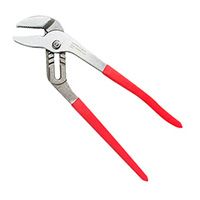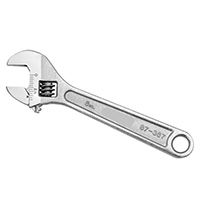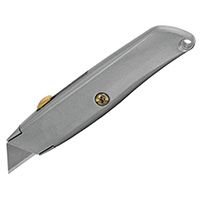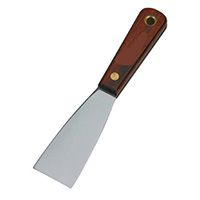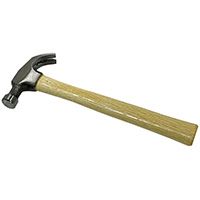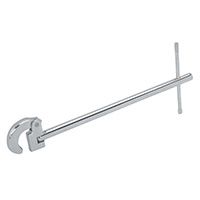Project details
Skill
Cost
Estimated Time
We may be compensated if you purchase through links on our website. Our team is committed to delivering honest, objective, and independent reviews on home products and services.
Whether you’re dealing with a broken pop-up assembly or leaky faucet, or you simply want to refresh your sink’s look, you can fix or replace your pedestal sink parts on your own and save time and money. This Old House plumbing and heating expert Richard Trethewey helps a homeowner replace various components of a pedestal sink, showcasing modern faucet designs that simplify installation.
Pedestal Sink Components
By familiarizing yourself with the main components of a pedestal sink, you can quickly identify what parts need a replacement.
Basin and Pedestal
The pedestal sink consists of two main pieces: the pedestal leg and the upper basin.
- Pedestal leg: This is the decorative support that conceals the plumbing connections.
- Upper basin: This is the actual sink portion where the water collects. It’s typically secured to the wall with bolts and sealed around the edges with putty.
Faucet and Water Supply
The faucet assembly includes several parts, from the handles and spout to the supply lines.
- Handles: Control the flow of hot and cold water
- Spout: The location where the water exits the faucet
- Supply lines: Flexible hoses that connect the faucet to the water supply valves
Modern faucets often come with color-coded connections and simplified installation methods, making replacement easier for do-it-yourself (DIY) enthusiasts and homeowners.
Drain Assembly
The drain assembly carries used water away from the sink through the following parts:
- Drain pipe: Connects the sink to the home’s plumbing system
- Overflow: A safety feature that prevents water from spilling over the sink’s edge
- Pop-up stopper: Allows you to fill the sink or let water drain

Prepare for Replacement of a Pedestal Sink
Here are all the tools and materials you’ll need for a successful pedestal sink replacement. Before you start, make sure all of your equipment is in proper working condition.
Tools and Materials
To successfully replace your pedestal sink parts, gather the following items:
- Basin wrench
- Bucket or rag
- Hammer
- New faucet assembly (including the stopper and drain pipe)
- Pliers
- Plumber’s putty
- Putty knife
- Replacement supply lines (if needed)
- Utility knife
- Wrench set
Remove the Old Pedestal Sink Parts
The first step in the replacement process is to carefully disassemble the existing sink components to avoid damage to the unit, connections, or wall. Follow these steps to remove the old parts safely and efficiently.
Turn off the Main Water Supply
To avoid water leaking everywhere during the project, make sure you turn off the main water supply:
- Turn off the water supply to the sink using the hot and cold water shutoff valves.
- Open the faucet to release any remaining water pressure and make sure the shut-offs hold.
- Place a bucket or rag under the supply lines to catch any residual water.
Disconnect Water Supply Lines
Use pliers to loosen the nuts connecting the supply lines to the shutoff valves, carefully remove the supply lines, and prepare for a small amount of water to drain out.
Remove the Basin
After turning off the main water supply and disconnecting the water supply lines, remove the basin as one of the first steps in the replacement process:
- Score along the wall with a utility knife to break the caulk seal between the sink and the wall.
- Loosen the bolts securing the basin to the wall using a wrench.
- Carefully lift the basin away from the wall, exposing the drain connection.
Detach the Drain Assembly
Use a basin wrench to loosen the nut connecting the drain to the sink. Carefully remove the pop-up assembly and any associated linkages, including the drain plug.
Install the New Pedestal Sink Parts
After pulling the sink away from the wall and removing the old components, you can install the new drain assembly and mount the new faucet. For the best results, carefully follow the manufacturer’s guidelines.
- Place the new drain assembly into the sink opening.
- Secure it from underneath using the provided gasket and nut.
- If your new faucet includes a push-button drain, insert it into place without the need for complex linkages.
- Apply plumber’s putty around the base of the new faucet.
- Insert the faucet through the holes in the sink basin.
- Use the provided installation tool to tighten the mounting nuts from underneath.
Reassemble the Pedestal Sink
Once you’ve replaced the components, reassemble your sink and test all of the new parts to make sure they work.
Secure the Basin
Start by securing the basin back to the wall for the proper support:
- Carefully lift the basin back onto the wall bolts.
- Tighten the bolts to secure the basin to the wall.
- Reposition the pedestal leg under the sink.
- Reseal all of the edges with caulk, if needed.
Connect the Water Supply
After securing the basin to the wall, connect the water supply once again:
- Attach the color-coded supply lines to the appropriate hot and cold connections on the faucet.
- Connect the other ends to the shutoff valves, ensuring a tight fit.
Final Connections and Testing
Test the sink after installing the parts to ensure water flows from the supply lines:
- Reconnect the drain pipe to the new drain assembly.
- Turn on the water supply and check for leaks.
- Test the faucet and drain functionality.
Troubleshooting Common Issues With Pedestal Sinks
Here are some problems you may deal with during installation and how to solve them:
- Improper drainage: Properly align the drain pipe and install the pop-up mechanism correctly.
- Leaks: Check all connections and tighten them as necessary. Check that the plumber’s putty and gaskets are secure.
- Loose fittings: Retighten any loose nuts or bolts. Be careful not to overtighten the connections, as you could damage the porcelain.
More Tips for a Successful Pedestal Sink Installation
Here are a few more factors to consider when planning your pedestal sink project.
Stubborn Nuts and Bolts
Some nuts and bolts may be difficult to loosen due to rust or old age. In these cases, apply a penetrating oil to help loosen them. Allow the oil to sit for a few minutes before loosening the nuts or bolts again.
Choose the Right Replacement Parts
Make sure the replacement parts you pick are compatible with your sink’s specifications. This includes checking the dimensions of the faucet holes, the drain components, and the water supply connections.
Secure the Fit
When reinstalling the basin and pedestal leg, make sure to properly align and level them. An uneven sink can lead to water pooling and potential damage over time. Use a level to double-check the alignment before tightening the bolts.
How to Care for Your New Pedestal Sink Parts
Here are some maintenance recommendations to help you keep your sink in top condition:
- Avoid using harsh chemicals that can damage the finish of your new faucet or sink.
- Check for leaks by wiping the area under the sink and inspecting for moisture.
- Clean the faucet and drain regularly to prevent buildup of soap scum and mineral deposits.
- Inspect the caulk seal between the sink and the wall. If you notice any cracks or gaps, reapply caulk to maintain a watertight seal.
- Tighten any loose nuts or bolts if you notice the sink becoming wobbly or unstable.
